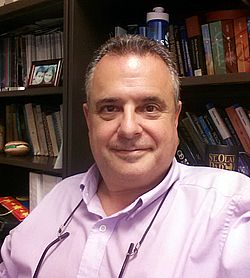
Fernando Sannibale, previously the principal investigator of the Advanced Photoinjector Experiment (APEX) at LBNL, has recently taken on a new role as leader of the ongoing ALS Accelerator Physics program in the Accelerator Technology and Applied Physics Division (ATAP) and will also serve as the ALS Division Deputy for Accelerator Operations and Development. Sannibale is taking over from David Robin, who is taking on a new role as project director of the Advanced Light Source Upgrade (ALS-U). We recently sat down with Sannibale to talk about his years at the ALS and what he hopes to accomplish in his new role.
What brought you to the ALS?
My career as an accelerator physicist began in 1991 in Frascati, Italy, and after many years there I was recruited to join the accelerator group here at the ALS in 2001. My wife and I had both enjoyed California and decided to make the move. When I first arrived at the ALS, I developed Beamline 7.2. I helped with a lot of projects over the years, including a new infrared ring proposal, the NGLS proposal, and most recently as principal investigator for the APEX project. That’s really been my focus for the past six to seven years. I’ve recently also been involved as part of the team that proposed ALS-U.
What do the next few years hold for you in your new role?
Getting CD-0 for ALS-U was great news recently, but there’s still a lot to be done just to manage ALS. There’s a pretty exciting list of beamline projects and upgrades that need to happen, and of course just keeping the ALS running for 2500 users is a big job. One of the main tasks for my new role will be interacting and coordinating with the ALS-U team to make sure we are making the most of resource sharing as we move forward.
What do you like most about working at the ALS?
The thing I really like here is the way people collaborate constructively, the enthusiasm. I’ve really enjoyed my small group too — they have very good skills and we enjoy one another socially. I enjoy both the technical/ scientific and the management/coordination aspects of my job, and as many in this phase of their career, I struggle to keep a proper balance between these two aspects. In this new job I will have a less direct involvement in technical/scientific activities but, on the other hand, I will now have the possibility of working on the “big picture” facilitating and enabling a broader range of exciting technical/scientific activities. I also really like working with people, trying to get the best out of them.
What’s a typical day like for you?
Like most people at the Lab would say, a little bit crazy. We are a small group, so there’s a lot of multitasking required. It’s sometimes frustrating, but it also gives you a chance to learn and be challenged by lots of different things. My last year was fully devoted to this APEX project. There are numerous problems to solve, which we did thanks to the high quality of all the groups involved here.
How did you end up in accelerator physics?
The person who was most influential for me was my father. He was a mechanical engineer. He had been a journalist and a movie cameraman for a time, but his passion was always science and math. My brother and I both grew up to be physicists. Growing up, every single dinnertime conversation was about science. My poor mother!
What do you like to do in your spare time?
I enjoy playing guitar and singing, but not in public. I was born in Brazil and grew up in Italy, so I like some of the more Brazilian styles of music. I also like wine—in Italy I got a certification as a sommelier. My two kids are in college now, but before they went away to college, they certainly took up a lot of my free time.